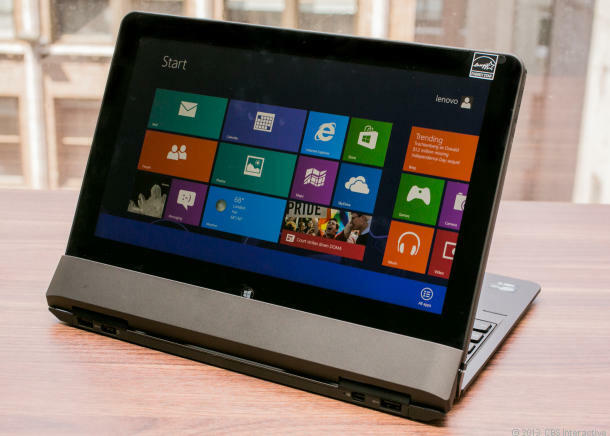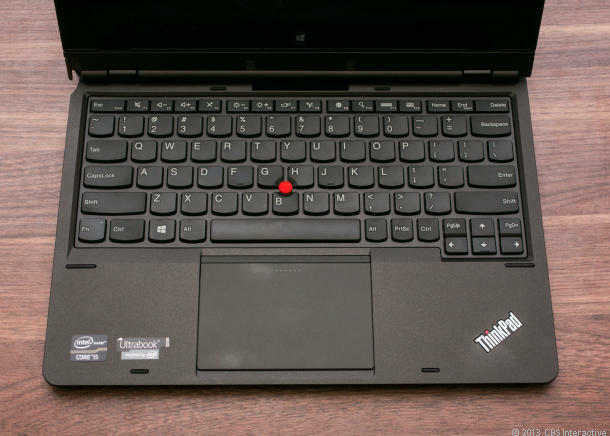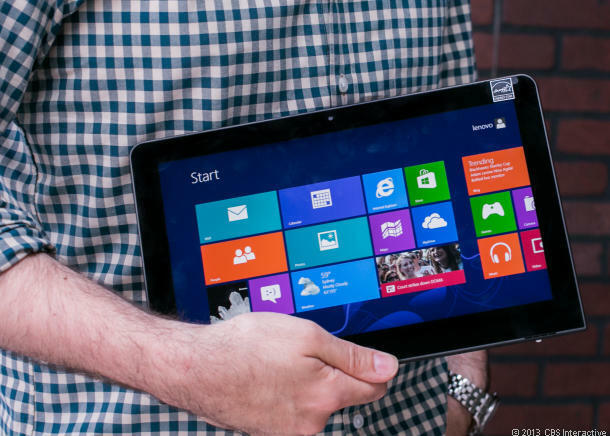When it was first introduced at CES 2013, Lenovo described the Helix hybrid laptop-tablet as a "flip and rip" system, which sounded like the usually staid company was trying to add a little sizzle to the normally conservative ThinkPad lineup.
In person, this detachable screen hybrid still has a very ThinkPad-like look and feel, and from a distance, looks nearly identical to the army of ThinkPads on office and cubicle desks around the world.
The flipping and ripping comes into play when you activate the small hinge-based latch for removing the display from the rest of the body. In this case, the screen pops off much like any other hybrid's, but then can reattach after being rotated 180 degrees, leaving the screen facing out from the back of the system. That makes for a good presentation mode, which I sometimes call a kiosk setup. Of course, you can also use the Helix screen by itself as a Windows 8 slate.
A crowded 11-inch field
But, as an 11-inch laptop, the Helix is in the middle of a suddenly crowded market. The Sony Vaio Pro 11 and 11-inch MacBook Air are on the traditional clamshell side, while Lenovo's own Yoga 11S and the Acer Aspire P3 are hybrids, although ones that work differently than the Helix.
Another potential stumbling block -- the Helix (like the Yoga 11S) is currently stuck with Intel's previous-generation processors, rather than the new fourth-generation Core i-series, called Haswell. The difference is important for a device such as this, because the battery life numbers we're seeing from the first few Intel Haswell laptops make the new chips more than worth waiting for, especially if you're going to be using a hybrid in its extra-portable tablet mode.
Because this system is from Lenovo's professional-grade ThinkPad line, as opposed to the consumer-targeted IdeaPad line, you can expect to pay a bit of a premium compared with other machines with similar specs. For a ThinkPad's rigid construction, best-in-class keyboard, and IT-friendly security features, that's perfectly reasonable, in theory. But, the Helix starts (starts!) at a frankly surprising $1,679, and for that, you only get a last-gen Intel Core i5 CPU, 4GB of RAM, and a 128GB solid-state drive (but, points for the 1,920x1,080-pixel-resolution display). Upgraded versions add faster processors, more RAM, larger SSDs, and mobile broadband, but those can cost north of $2,000, and all include a digitizer stylus.
Design and features
Despite misgivings about the price and older components, Lenovo has created the best detachable-screen latching system I've seen. It's still overly fiddly, with multiple hook-and-eye-style connections, but it feels more robust and solid than other detachable hybrid hinges, and the release mechanism is a large push-in button on the left edge of the hinge, rather than a cheap-feeling button right below it (as found on the HP Envy x2and other hybrids).
There's even a short horizontal panel that covers the entire hinge mechanism from the rear of the system, both to protect it from the elements and to give the entire package a cleaner look. I've taken to calling it the Helix Modesty Skirt.
The rest of the physical design is up to Lenovo's usual impeccable ThinkPad standards. The matte black chassis feels like it could take a bullet, and the standard island-style ThinkPad keyboard, with keys slightly curved at the bottom, is impossible to top.
At 3.7 pounds for the screen and body (not including the power cable), it's hefty for an 11-inch laptop, but note that there's a three-cell battery in the tablet and a separate four-cell battery in the keyboard dock.
Source : Cnet.
Login to the community
No account yet? Create an account
Enter your username or e-mail address. We'll send you an e-mail with instructions to reset your password.





